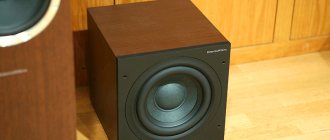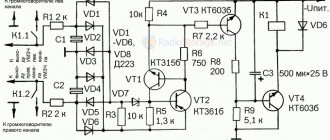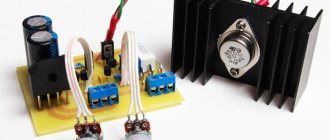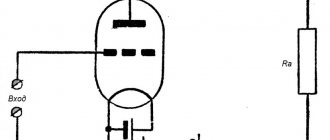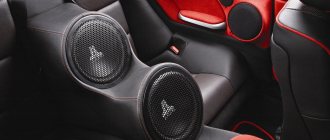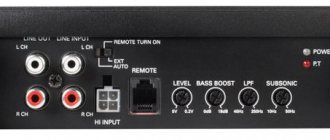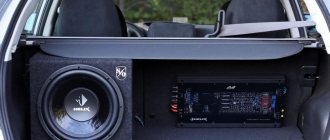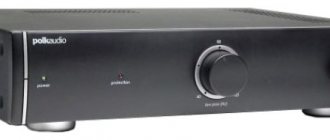In theory, installing a subwoofer in a car is not at all difficult. It is enough to choose a suitable model in terms of power and find a place for it. However, in practice it is not so simple. In particular, in sedan-type bodies, a sub placed in the trunk sounds very muffled. In a small cabin, a powerful low-frequency speaker makes the body assembly units vibrate.
For users who do not have special knowledge, an excellent option for obtaining low frequencies in the sound picture would be a subwoofer in the car under the seat. Such a device is easy to install, connect, and does not take up much space.
Subwoofer under the car seat - always with music
Subwoofer under the car seat - installation of an active subwoofer in the car makes it possible to significantly improve the quality of the sound picture in the car interior.
Juicy and elastic bass is formed, and rich dynamics and rhythm are clearly visible in the sound. And what is important is that the rattling sound produced by plastic panels, which is typical when installing a subwoofer, is not observed. Therefore, I would like to share my experience of installing a subwoofer under a car seat.
The principle of installing a bass speaker under the seat
In order to integrate an active acoustic bass system under the driver's seat, you will need to purchase the appropriate acoustics or make it yourself. Personally, when I started implementing this project, I decided not to invent anything special in terms of making an audio system. Therefore, I did a simple thing - I bought an industrial-made bass speaker with dimensions suitable for installation. Moreover, the configuration of this subwoofer included all the necessary fastenings for the device. All this greatly facilitated the installation process. Moreover, in such a non-standard place as a niche under the driver’s seat.
Before you start installing the subwoofer under the car seat, it is advisable to carefully study the instructions that came with it. This way you will probably already know how to properly connect the amplifier and car radio, so you will avoid mistakes. Next, you will need to remove the seat from the passenger compartment, under which you intend to mount the subwoofer.
Wiring
Now you need to correctly route all the necessary wires and install the sub in the designated place. It must be secured in such a way that you can easily service it in the future. That is, you should be able to easily reach controls, fasteners, etc. with your hand. Otherwise, when you need to change, for example, the operating mode of the active subwoofer or there is a need to turn it off, then in this case you will need to remove the seat. And this will already constitute some inconvenience.
In this regard, you should accurately align the location of the device, which would correspond to its optimal position with free access to it. After this, start attaching it. First, you need to trim the rug a little, and then use screws to screw the dynamic emitter to the panels. In some cases, due to the design of the seat, it will be necessary to upgrade the strips that prevent the speaker from standing up normally.
In some car models, it is not possible to easily attach the subwoofer to plastic elements, then you can use wood material as the basis for mounting the subwoofer. But first, for an aesthetic appearance, cover the wooden base with felt in the corresponding color of the interior floor covering.
Power fuse
A 10A fuse must be installed in the subwoofer fuse block, which is connected in series to the positive supply voltage wire circuit. Voltage is supplied to the active subwoofer via a separate wire with the function of turning on the voltage when turning the key in the ignition. The control unit receives power via a wire connected to the cigarette lighter. In my car, the power cord ran along the left side of the cabin. In this case, it was necessary to slightly bend the covering material, and then temporarily dismantle the plastic facing elements of the threshold.
The entire wiring harness must be laid in a safety corrugated tube. This is due to the fact that water gradually accumulates near the thresholds of the cabin, which can harm the on-board wiring. The output of the power amplifier is connected to the subwoofer using speaker wires of the required cross-section. On the front panel of the device there is a knob for adjusting the bass.
At the final stage of installing the active subwoofer, you should check how the entire system works; if there are no complaints and everything works fine, then we put the seat in place.
Alpine PWE-V80
- decent sound (minimum nonlinear distortion);
- build quality (nice case material, all elements fit perfectly);
- equipment (in addition to the standard set, there are very long wires for connection: they will reach any place in the cabin; there are even mounting brackets with screws for the body and body);
- in the case - a ready-made solution that does not require creating a sound box or screwing it into the interior frame.
- medium-power;
- The bass is harsh, not for everyone.
Active subwoofer. A crossover (a device that separates music into a spectrum of frequencies and supplies speakers with their corresponding frequency characteristics) filters from 50 to 105 Hz. There are a lot of wires in the package, and they are very long. There will be no problems with connecting the power supply. It is connected to the radio through its usual outputs, the amplifier independently cuts off the high frequencies. Maximum power 160 watts. This is quite enough for a medium-sized cabin.
How to choose an active subwoofer for a car
Top 8 sound amplifiers of 2022 and how you can make the device yourself
Let's consider the criteria that will help you buy an active subwoofer for your car and not make a mistake in your choice.
Peak power. It is with the help of peak (maximum) power that the majority of buyers are attracted. After all, car owners first of all want to know whether it can attract the attention of others. Peak loads indicate at what level the speaker can perform most efficiently. Most often, they are about three times higher than the indicators that are optimal for long-term operation, but devices with such characteristics are often at the very top of the subwoofer ratings. When choosing which active subwoofer for your car is better, be sure to pay attention to this criterion. Rated power. The manufacturer tries not to focus attention on this parameter - this indicator is not as impressive as the previous one. But it is this information that tells the buyer what level of sound the selected speaker can produce without distortion. At the same time, it can operate at higher powers in optimal mode. Most car enthusiasts who decide to purchase a subwoofer are not looking for high power. Therefore, the optimal devices are those whose indicator ranges from 200 to 300 W, which is quite enough. Input resistance (impedance)
There is one important rule that states that the resistance must be fully supported by the amplifier, otherwise the equipment may malfunction. If, for example, a subwoofer with an impedance of 2 Ohms is connected to an output designed for 4 Ohms, then the output stage of the amplifier will most likely burn out
Sensitivity. Sensitivity is the ratio of the diffuser area and its stroke. In order for a speaker to play loudly, it needs a large diffuser and a long stroke, but often manufacturers make a huge suspension, an impressive lip. People think that a speaker has a lot of excursion and plays louder, but in fact it loses power to speakers with a larger cone. You should not give preference to subwoofers with a large lip; it loses to a small one, because a speaker with a large diffuser has a higher efficiency. So, a large stroke is nice, but the diffuser area is much more useful.
Review Pioneer TS-WX11A
A very powerful and compact bass driver that will add lively, bright and energetic lows to the car’s acoustics. To ensure guaranteed power, the Pioneer subwoofer includes a die-cast aluminum heatsink, an oval driver woofer, and, of course, a built-in Mosfit FET amplifier.
Read also: Air mattress for car
Peculiarities
- Power (at peaks) – 150 W;
- Power (nominal) – 50 W;
- Work with frequencies – 54-200 Hz;
- Sensitivity – 101 dB;
- Typical size – 20 cm;
- Built-in and adjustable low-pass filter;
- There is a remote control that operates at 6 meters.
Advantages of compact buffers
Design and principle of operation of airbag and srs systems
The career of any new product in car audio goes through several stages:
- Surprise of the public - wow, they came up with it! The news will “promote” the product until the technology ceases to be news;
- The second stage involves full acquaintance. If I may say so, the public will demand the device “on the carpet” at this stage in order to evaluate its declared advantages, to test it “by the tooth.” And at this period of career growth, many devices do not pass such an exam and are forgotten about, which explains the stop in production due to the gradual fading of demand;
- Finally, the third stage, from which no known device is immune, involves leaving the stage, no matter how shining and cloudless the device’s career may be. Time passes, priorities and demands change, fashion and everything connected with it undergo dramatic changes.
Today is the time for compact subwoofers to hit the carpet, having already matured enough and taken root in the world of car audio.
Compactness
First, let's figure it out, since when did compactness itself become a species-forming characteristic? It turns out that it did not become so on its own, but the transition from quantity to quality retains its relevance, if not in dialectics, then certainly in mentalities. Let's give an example of the volume of well-known standard subs:
- As a rule, if the buffer has normal technical characteristics, then the volume is equal to 90-100 liters, which definitely puts an end to the functionality of the trunk (nothing else will fit here), and it is impossible to install such a large speaker in the cabin;
- There are speakers with a volume of 30-60 liters, which is a little better. But again, it will take up a lot of space in the trunk, and access to the cabin is still closed to it;
- Speakers with a volume of 15-20 liters can be hidden in a secluded corner, but still in the same trunk.
Form
It is interesting that in this case attention is focused not only on compactness and size. The shape of the speaker is also important
So, no matter how small in size it may be, its square or “barrel-shaped” shape can negate all its advantages. A compact subwoofer must be flat and that's it!
As surprising as it may be to hear, the form begins to dictate the content. In other words, the material of the housings will depend on the shape of the speaker. As a rule, the boxes of compact subs under the seat are cast from an alloy of aluminum and magnesium.
Speaker selection
How do car airbags work: design and principle of operation
Homemade sub for cars
Before you build a subwoofer in your car, you need to decide on the choice of speakers.
Today you can find speakers of the following sizes on sale:
- Six inches. As a rule, such devices are used as an additional source for reproducing mid frequencies. In practice, such a device can be used to make a modest subwoofer in terms of frequency depth. This speaker is ideal for cars with a small interior and average acoustics overall.
- Eight-inch variants can be used to provide additional front frequencies. In fact, this option is also quite modest.
- Ten-inch speakers or larger are the best option if you decide to build a homemade subwoofer. Such devices allow you to provide the highest quality sound, while filling the interior space with quite pleasant and strong bass. As practice shows, the best option for making a subwoofer in a car is 12-inch speakers.
- 15-inch speakers are the best option for large vehicle interiors. But at the same time, this option is practically not feasible, since to achieve high-quality sound you will need a box with a volume of 90 liters. Not only will it take up almost the entire trunk, but it can even stun the driver.
Drawing for making a subwoofer
If you are thinking about how to make a speaker yourself, then in addition to the size, you should also decide on the resistance level. For example, the most optimal option would be a resistance of 2-4 ohms; if this figure is lower, this will significantly affect the sound quality. As for the power of the speakers, in this case it is difficult to say anything for sure, since disputes regarding this issue are still ongoing. One thing is for sure - the power of the speaker must be greater than the power of the amplifier, since no device can work for a long time if it operates at the highest power. It’s easy to do for box, but if you do it without calculations, it will play poorly.
Sub under the seat: what this compact device can do
In theory, installing a subwoofer in a car is not at all difficult.
It is enough to choose a suitable model in terms of power and find a place for it. However, in practice it is not so simple. In particular, in sedan-type bodies, a sub placed in the trunk sounds very muffled. In a small cabin, a powerful low-frequency speaker makes the body assembly units vibrate. For users who do not have special knowledge, an excellent option for obtaining low frequencies in the sound picture would be a subwoofer in the car under the seat. Such a device is easy to install, connect, and does not take up much space.
Where to install: in the trunk or under the seat
If an active subwoofer can be placed almost anywhere, then the purity and power of its sound at low frequencies will directly depend on the location of the passive device. Depending on the preferences of the car owner and the availability of free space in different types of cars, several installation locations are offered:
- in the center in front is the optimal position for communication with the front speakers, which will ensure almost perfect sound of tracks in the cabin. However, most cars don't have room in the front to accommodate any large devices, so a center front location is more suitable for minibuses;
- in the trunk, with the speaker directed forward - one of the most popular ways to place a subwoofer among drivers. Suitable for all types of vehicles;
- in the trunk, with the speaker directed backwards - more suitable for a car in a hatchback body, since the sound wave does not encounter obstacles in its path. The location in the trunk back is unacceptable for cars in a sedan or coupe, since the sound will be greatly deformed due to the specific design of the luggage compartment;
- on the floor under the seat is another option, which, however, is not widely popular among drivers. Due to the fact that the subwoofer is located flush with the floor, and the housing is located under the seat, the sound encounters many obstacles in its path;
- on the rear parcel shelf is one of the best options for placing a subwoofer in all types of cars. The main condition is that the shelf must be wide and strong enough to withstand low-frequency bass.
Photo gallery: main places to place the device in a car
When choosing a location to install a subwoofer, you need to accurately calculate how safe the bass energy will be for surrounding objects. The fact is that resonance from the housing can, in some cases, damage both the installation site and the glass in the car.
What to make a box from
A subwoofer box is more than just a box that houses a speaker. The box must comply with many dynamic laws of acoustics in order for the sound to be truly rich and clear. To make different types of boxes, different materials will be required, and the manufacturing methods will in many ways be different from one another.
How to build a box for a bass reflex subwoofer
The standard version of a homemade subwoofer is a bass reflex. This is the simplest type of subwoofer; moreover, its box is good because a special bass reflex tube allows you to reproduce low frequencies that are practically not perceived by the human ear. And the design of the box is quite simple, which makes its production accessible to almost everyone.
- sound insulation;
- wood screws 50 mm long;
- drill;
- screwdriver;
- electric jigsaw;
- liquid Nails;
- sealant;
- PVA glue;
- carpet
To make the case you need to follow this plan:
Prepare parts of the body: front, back, two sides, bottom and top in accordance with your calculations or parameters derived by programs. To fit the speaker size (for example, diameter 160 mm), cut a hole in the front part of the housing blank. Above the hole for the speaker you will also need to cut a slot for the bass reflex tube and screw the bass reflex compartment to it. After two holes are made on the front panel, you need to glue all the side parts of the box together and then screw them to each other with self-tapping screws. In this case, it is especially important to tighten each screw until it stops, since empty spaces between the panels will seriously distort the sound of the speaker. Next, you will need to cut a small hole for the wires on the back of the case. Before connecting all parts of the case, we insert the speaker. Next, it is necessary to carry out the interior finishing of the case: for this, all joints and cracks need to be coated with resin or sealant to improve the sealing, after which soundproofing fabric is glued to all side panels. After completing the interior decoration, you need to move on to the exterior: the body is covered with carapet fabric, and the fabric should also cover the slot for the bass reflex. The Karapet can be tensioned using regular epoxy or a furniture stapler. Once the speaker is secured, wires are pulled from it through the hole and connected to the car's speaker system
Once the speaker is secured, wires are pulled from it through the hole and connected to the car's sound system.
How to make a Stealth subwoofer box with your own hands
Despite the sound quality of a bass-reflex subwoofer, not every driver wants to carry a large box in the trunk. In some cases, the luggage compartment must be filled with things and cargo, so there is no room left for a subwoofer.
The logical way out of the situation is to make a Stealth subwoofer for the trunk. It will provide the same low-frequency sound quality as a bass reflex, but will take up minimal space.
Usually the Stealth subwoofer is installed directly in the trunk, but there are often cases of installation inside the fender or even in the spare wheel well.
The minimum volume required for normal operation of the Stealth is 18 liters, provided that a 12-inch speaker is used.
Materials and tools
To make your own Stealth subwoofer, you need to prepare in advance:
- speaker grille;
- speaker;
- socket for connection;
- wires of the required length;
- plywood or chipboard 20 mm thick;
- a piece of fiberboard;
- epoxy glue;
- brush;
- fiberglass;
- masking tape;
- polyethylene;
- wood screws (40 mm);
- jigsaw;
- drill.
How to choose a subwoofer
Choosing the right subwoofer is not only a question of the quality of the speaker or the power of the amplifier. Its design itself has a noticeable “tailoredness” to specific styles of music - for example, subwoofers with a bass reflex are perceived by ear as having a sharper attack (the rear volume does not dampen the movement of the diffuser, and also acts as a sound source), so they have long been loved for synthetic “tink-tink” ”, while the softer and more natural-sounding attack of the closed-back subwoofers will allow you to enjoy not only the blues, but also many rather extreme styles of instrumental music on the move. A Band-pass type case, where the diffuser works on the internal volume on both sides, and all the sound comes out through a hole in the box, gives maximum efficiency, but with a pronounced “hump” in the region of a certain frequency band - such a subwoofer can only be recommended for certain tastes , so in any case you need to listen to a specific instance.
Which subwoofer is better - active or passive? Here the question is solely about budget and requirements: of course, an active subwoofer is easier to connect and install, but sound quality will most likely have to be sacrificed - it’s not for nothing that most high-end products are passive, the amplifier for them is already selected for a specific installation.
Closed enclosure, bass reflex or bandpass? But let’s answer this question simply - choose a subwoofer by at least listening to it in a car of similar volume, and not in a store: the difference will be very strong. And, of course, listen to exactly the music that you like - then you can understand exactly how suitable it is.
Which brand's car subwoofer is better? Over the years, the domestic car audio equipment market has developed a group of favorites whose products are always popular. Car subwoofers from companies such as Sony, Alpine, Pioneer, Helix, JBL, Kicx, Yamaha and other famous manufacturers have long proven themselves to be the best.
Best models
The rating includes models with the largest number of positive reviews.
Pioneer TS-WX70DA
The device takes first place in the ranking of the best compact subwoofers. It can be placed under any seat. The manufacturer does not declare any special operating conditions. The 15cm diameter speakers are powerful enough to produce deep bass. The positive qualities of the product include:
- no protruding parts;
- small sizes;
- stylish design allowing for open installation;
- rich bass;
- several operating modes.
The disadvantages of the Pioneer subwoofer include the low quality of the installation cables, the control panel on a wire, and deterioration in sound quality with increasing power.
Pioneer TS-WX210A
The model has a minimum amount of internal space. This allows you to place the subwoofer in any car, without taking into account the height and method of installing the seats. The rich bass produced by the 8-inch speaker is adjustable. Other advantages include the following:
- high sound power;
- the ability to change the cutoff frequency;
- increased power;
- small body size;
- reliable fastening.
Negative qualities include the lack of installation cables included, only the bottom part is attached, a wired remote control, and a high price.
Mystery MBS-204A
Low cost makes this model popular among buyers. It represents good value for money. However, installation of the product will require special skills. The advantages of the model under consideration include:
- stylish neat design;
- presence of a built-in amplifier;
- the presence of a separate volume control with an LED element;
- good sound quality.
The following points are considered negative qualities:
- poor quality of cables included in the kit;
- bad fuse;
- increased brightness of the LED component on the volume control panel;
- the occurrence of interference that can degrade sound quality.
Alpine PWE-V80
The model is capable of replacing an amplifier located in the luggage compartment. A power of 160 W is enough to pump the interior of an SUV. The device is not suitable for lovers of soft classical music. The sub produces powerful, rhythmic sounds. The advantages of the model are the following qualities:
- presence of a built-in amplifier;
- stylish flat body;
- high power;
- normal sound quality.
The disadvantages are the harsh sound of the bass (due to a small volume of air), pronounced vibration (installation of feet or a rubber backing is required), and high price.
Pioneer TS-WX130DA
The device is used as an auxiliary component of an audio system. It is not capable of producing rich, rich bass. To obtain the desired sound quality, use the buttons located on the remote control. There are functions for phase shifting and changing the cutoff frequency. This sub for installation in a car contains the following positive qualities:
- neat small body;
- ease of installation and connection;
- presence of an amplifier;
- several operating modes and settings options.
The disadvantages include low power, deterioration in sound quality when choosing maximum parameters.
How to make a homemade subwoofer for a car - types of boxes
Before assembling the subwoofer into the car with your own hands, you need to decide on the layout and type of box.
You can assemble the box in several ways:
- Horn design;
- Closed box;
- Bass reflex;
- Passive radiator (analogue of a bass reflex);
- Bandpass;
- Quarter-wave resonator.
Let us briefly define each of the proposed options and focus on building one of the boxes.
Subwoofer type – horn
Horn-shaped design. Its advantage: the clarity of directional sound in one specific direction.
Subwoofer box
The design does not have frequency emitters on the body. Assembly of the box is simple. The main thing is to adhere to the parameters specified in the drawing.
Subwoofer for car - bass reflex
In this version, a special feature is the arrangement of holes of different diameters on the body of the box. This design allows you to increase the efficiency and allow free flow of outgoing air.
Subwoofer type for car - passive radiator
The speaker body with different holes is essentially an analogue of the previous version of the box. Difference: a small diffuser without a voice coil is built into the body. Assembling the structure will not be difficult if you have the material and tools.
Quarter-wave resonator.
The box is shaped like a pipe. Design presents certain difficulties for a beginner. But the work will pay off with high-quality sound at low frequencies than the other designs described above.
Having decided on possible designs and choosing the required option, let’s use a bass reflex as an example to build a box. Let's find out the order and sequence of production.
PIONEER TS-W106M
- amazing power;
- strength and elegance of design;
- new technological materials (IMPP).
- there is no body, which implies additional costs for creating the desired design.
Working 250 watts (the maximum is a crazy 1100 watts) will pump up even a large jeep. The assembly is very high quality and strong. The diffuser itself (the working plate of the emitter), according to the manufacturer, is made of a very durable and musically expressive material of the new generation IMPP. There is no housing, but it can be easily mounted anywhere (depth 120 mm, diameter 230 mm): trunk, door, seat, fender.
How to properly connect a subwoofer to a car?
After purchasing a device, the question naturally arises about whether it is installed correctly in the car. Sometimes you can get confused by the number of supplied wires and adapters. However, this procedure is not as complicated as it seems at first glance; the main thing is to follow the basic principles for connecting an active subwoofer.
- Prepare the car interior. First, you need to remove the casing so as not to pull wires along its surface, clean the existing screws from traces of paint or other materials in order to make a reliable installation.
- Remove the terminals from the battery. This is a very important step! Since it is necessary to work with a de-energized battery to avoid an accident.
- Power wiring. After this, we pull the power wiring (most often this is the thickest cable in the kit). It has a fuse that connects to the positive terminal of the battery. When laying, avoid bending and twisting of the cable.
- Remote wire connection. This cable is responsible for directly turning on the device. It is mounted to the car's standard radio - to a wire of the same or similar sound.
- Signal wire connection. Reaches to the radio if it has a linear output for a subwoofer. If it is missing, switching is done to the standard system using the high-level input included in the kit. It is best to install this cable on the opposite side of the power cable.
It is worth emphasizing that the equipment included in different models may differ; you should strictly follow the instructions included with the device.
We make a housing for a subwoofer with our own hands
What material is best for making a subwoofer enclosure with your own hands?
- Chipboard (chipboard) is the most suitable option; it is cheap and easy to process. You should choose chipboard with the highest density. A thickness of 16mm or greater will do. Chipboard easily absorbs moisture and swells, so it is advisable to paint it.
- Fiberboard (fibreboard) - like chipboard, you should choose the highest density. It flakes easily, especially when wet. You should work with fiberboard carefully so as not to spoil it. Despite its shortcomings, it is a convenient material for quickly building a subwoofer enclosure for a medium-power speaker.
- Plywood. Plywood made from Russian birch or ship's wood is suitable. Most other grades of plywood are not dense enough, resulting in distorted sound.
If there are sheets of chipboard, fiberboard or plywood, but their thickness is not enough to provide the required structural rigidity, you can fold two sheets together, fastening them with sealant (or PVA, wood glue) and self-tapping screws.
So, making a subwoofer enclosure with your own hands is not at all difficult.
Hertz ES 300
- the softest, deepest bass;
- excellent design: the device looks futuristic, but not pretentious;
- the size of the range of reproduced frequencies, that same infrasound is present;
- high-quality materials, special attention is paid to their ability to dampen parasitic vibrations.
- contacts on spade terminals;
- there is no body, which implies additional costs for creating the desired design.
The Italians from Elettromedia admire the design. Externally, a very expressive car sub. The diffuser holder is rubberized. In general, everything that can create rattling is “drenched” with damping material, a noise-attenuating structure. The magnet itself – 141 mm in diameter – is also solid.
Like all compact subwoofers for cars without a “house,” this one is in dire need of it. The best volume for it is about 20–30 liters, preferably with a spacious bass reflex. By the way, you can assemble a speaker structure in any form factor: flat, square, trapezoidal. This will allow for the most optimal placement of the device itself. Good sensitivity. Nonlinear distortions are minimal. Very wide frequency range (25–250 Hz). Now a modification of Hertz ES 300.5 has already appeared.
How to choose a subwoofer for a car
Purchasing a subwoofer for installation in a car is accompanied by the need to comply with a number of specific nuances and rules, which will determine not only the amount of costs, but also your personal enjoyment of use.
Therefore, when choosing a bass player yourself, Expertology recommends paying attention to five key aspects:
- Dimensions
. The main and obvious selection parameter, failure to comply with which can lead to significant problems with placement in the trunk (or under the seat). As a rule, in modern car models, places for installing a subwoofer are allocated separately, which in itself imposes (albeit not strict) restrictions on its dimensions. In the vast majority of cases, power indicators directly depend on the size of the model. Therefore, if the nominal performance characteristics of the “woofer” fitted into the seat do not suit you, consider purchasing a more productive model. - Power.
A characteristic showing the degree of durability of the subwoofer speakers. In general, the higher the nominal value, the better. The maximum power, in turn, shows the magnitude of the short-term peak impulse that the acoustics can withstand without mechanical or other damage. - Number of acoustic bands
. A parameter that directly determines the accuracy and sound quality of music through the subwoofer. Efficiency increases according to the “bigger-better” relationship, but naturally affects the increase in the price of the speaker system element. - Amplifier.
Not only its total cost, but also a fundamental difference in sound reproduction depends on the presence or absence of an amplifier in a subwoofer. Subs without an amplifier provide a significant increase in the bass component of the music against a background of weak sound, while models with an amplifier provide a smooth increase in both components. - Frame
. Many consumers note that the type of enclosure does not play a big role in the selection of “barrels” for a car, but at the same time they are willing to buy models with a strong chipboard construction and fabric upholstery, rather than subwoofers with a different type of enclosure. In fact, both the sound transmission quality factor and the overall reliability of the product depend on its execution. Good fastening of the speaker in the mounting socket ensures the absence of parasitic vibrations and noise, and also prevents the possibility of spontaneous mechanical damage if the fastening is not tight.
The best bass reflex subwoofers
The main advantage of subwoofers with a bass reflex is the ability to save installation space: the design of such a low-frequency speaker can be significantly smaller, while maintaining all the parameters of power and bass purity.
Alpine XW 12D4
5
★★★★★
editorial assessment
100%
buyers recommend this product
The new product from Alpine is designed for installation in premium speaker systems with a large reserve of sensitivity ranges from 23 to 100 Hz. The rated power of the 12-inch driver is 900 W. Dual voice coil technology with a profiled cooling channel allows it to withstand such a load.
The diffuser design has a HAMP suspension - this eliminates resonant noise at a maximum power of 2000 W. The diffuser is covered with a dustproof cap made of polypropylene, the grill is secured with a bayonet-type damper connection.
To obtain the highest possible sound performance, it is recommended to install the sub in a box with a volume of 25.5 liters. The bass reflex will require 51 liters with two output ports of different diameters.
Pros:
- Double coil;
- High-quality speaker materials;
- New damper suspension system;
- Active cooling;
- High sound pressure.
Minuses:
- High price (from 18,000 rubles)
Alpine XW 12D4 is a new level of technology for balancing powerful bass, but you have to pay a lot for it.
Edge EDP122SPL-E6
5
★★★★★
editorial assessment
97%
buyers recommend this product
The passive bass reflex subwoofer has an increased power of 1500 W. At its peak, this monster produces 4500 watts. The dual voice coil can operate at high temperatures due to ventilated cooling.
With such power, the woofer measures only 12 inches and provides a good sensitivity of 83.7 dB.
Pros:
- Ferrite magnet in design;
- Cast aluminum basket;
- Excellent multi-channel cooling;
- Built-in suspension;
- Damper mounting of the diffuser.
Minuses:
- Requires a powerful amplifier.
The Edge EDP122SPL-E6 is often used in car audio competitions. But when installing it in a car, it is necessary to accurately calculate all the parameters, selecting special cables and an amplifier.
Audison TH K2 II A Coro
4.9
★★★★★
editorial assessment
95%
buyers recommend this product
The new generation two-component acoustics consists of a 165 mm woofer and a 38 mm dome tweeter. A power of 150 W when operating in the system gives high sensitivity levels of 22-880 Hz at 87 dB.
At a peak power of 300 W, the sub maintains pure sound without extraneous noise. The range of application of such a kit in combination with midbass is very wide. In fact, this is a full-fledged subwoofer with advanced functions of a built-in tweeter.
Pros:
- Bass reflex;
- Extended frequency range balance;
- Quality materials;
- Original design;
- Possibility of connecting an equalizer.
Minuses:
- Lack of diffuser protection
Audison A Coro is a premium acoustic system that, when installed in a standard audio system with mid-range speakers, replaces a subwoofer and tweeter.
How to calculate hull displacement
What is the volume of the case? This is one of the main quantities on which the sound of the speakers in the subwoofer will directly depend. There are two ways to calculate the volume of the case: using professional programs or manually.
In addition, the programs will calculate the dimensions of all parts and elements necessary for manufacturing, so you just have to take the derived parameters and make a box based on them.
How to calculate the volume of a case manually
Calculations without the use of specialized software are simpler, although it will be impossible to imagine the model of the future subwoofer or the dimensions of its housing.
The volume of the box is calculated using the formula V = h*L*A.
In this case, the following values must be substituted into the formula:
- h is the height of the box;
- L is the length of the box;
- A is its height.
Knowing all these parameters, it is easy to determine the volume of the subwoofer housing.
The program algorithm will take into account all your wishes and calculate the volume and other parameters of the case quickly and correctly
Advantages of compact buffers
Active subwoofer in a car under the seat
The career of any new product in car audio goes through several stages:
- Surprise of the public - wow, they came up with it! The news will “promote” the product until the technology ceases to be news;
- The second stage involves full acquaintance. If I may say so, the public will demand the device “on the carpet” at this stage in order to evaluate its declared advantages, to test it “by the tooth.” And at this period of career growth, many devices do not pass such an exam and are forgotten about, which explains the stop in production due to the gradual fading of demand;
- Finally, the third stage, from which no known device is immune, involves leaving the stage, no matter how shining and cloudless the device’s career may be. Time passes, priorities and demands change, fashion and everything connected with it undergo dramatic changes.
Active subwoofer in the car under the seat
Note. In the recent past, cassette recorders, CD changers, and video devices took place in such careers in car audio.
Today is the time for compact subwoofers to hit the carpet, having already matured enough and taken root in the world of car audio.
Compactness
Active subwoofer under the seat
First, let's figure it out, since when did compactness itself become a species-forming characteristic? It turns out that it did not become so on its own, but the transition from quantity to quality retains its relevance, if not in dialectics, then certainly in mentalities. Let's give an example of the volume of well-known standard subs:
- As a rule, if the buffer has normal technical characteristics, then the volume is equal to 90-100 liters, which definitely puts an end to the functionality of the trunk (nothing else will fit here), and it is impossible to install such a large speaker in the cabin;
- There are speakers with a volume of 30-60 liters, which is a little better. But again, it will take up a lot of space in the trunk, and access to the cabin is still closed to it;
- Speakers with a volume of 15-20 liters can be hidden in a secluded corner, but still in the same trunk.
Active car subwoofer under the seat
Note. Only when the volume of the buffer reaches a single digit is entry into the salon guaranteed. There is nothing left for him to do in the luggage compartment, because he easily fits under any of the front seats.
It is interesting that in this case attention is focused not only on compactness and size. The shape of the speaker is also important
So, no matter how small in size it may be, its square or “barrel-shaped” shape can negate all its advantages. A compact subwoofer must be flat and that's it!
Active car subwoofer under the seat
As surprising as it may be to hear, the form begins to dictate the content. In other words, the material of the housings will depend on the shape of the speaker. As a rule, the boxes of compact subs under the seat are cast from an alloy of aluminum and magnesium.
Note. It's easy to explain. If the body were made of plywood, as is customary, then, given the low height of the box, the walls would account for about 3-4 cm of thickness or, roughly speaking, half the volume of the body.
Subwoofer lanzar vctbs 8active, under the seat
Accordingly, the shape begins to dictate the speaker installation technology. In this case, everything is simple:
- Mounting the speakers involves installing them on a plane. In this case, the sound emitter must be directed upward;
- In no way should the head be positioned horizontally or even at a slight angle, as is the case with standard subs.
Emitters
As a rule, the drivers or heads in underseat subwoofers (see Installing an active subwoofer in your car yourself) are 8 inches. They are most often made in a “slim” design, which contributes to their convenient location in flat, thin cases.
Note. On the other hand, there are also heads whose size is much larger. 120 mm or 165 mm emitters are also placed in compact buffers.
Active subwoofers under the seat
You should not expect the following from both the first (8-inch) and second emitters:
- Serious sound pressure;
- Low nonlinearity indicators.
Naturally, much will depend on the design of the emitters themselves, but this does not exclude general patterns. Most underseat subs have a maximum sound pressure of 100 dB and no more.
Advantages and weaknesses of an underseat bass driver
Features of the Gazelle gearbox: design and repair
Active compact subwoofer in car
Let's discuss the topic of compactness a little before moving on to the description of subwoofers. Let's consider the important points:
As a rule, the usual volume of a woofer is 90-100 liters. What does it mean? And the fact that in this case you can say warm regards to the trunk. It will be necessary to place various things here in limited quantities.
- But the compactness of a modern speaker is not limited to this. Boxes are also available for 15-20 liters, or even 10-12. They can already be hidden in a secluded corner of the trunk. But subwoofers are even smaller in size and easily fit under the driver’s seat;
- Such a woofer is usually called a super-compact or “form factor”. Such speakers are made in the form of a flat rectangle, like an amplifier;
- The material of the speaker housing is also important, which is usually cast from an aluminum-magnesium alloy. For example, with a case height of 7-8 cm, if the case material is made of MDF, then the walls will account for 3-4 cm, which is half. As it becomes clear, such a situation cannot be called correct;
- Secondly, the design of the box itself provides for installation on a plane. The head should be directed upward, but in no case horizontally or at an angle.
Underseat woofer
As for quality, “underseat” bass speakers, as super-compact subwoofers are also called, have advantages over conventional “luggage” speakers. They almost completely eliminate the problem associated with bass localization.
- The ultra-compact “underseat” woofer is capable of reproducing bass with impeccable accuracy, although without infrasound;
- In addition, compact bass speakers will be able to show themselves in a more favorable light inside the car. One can even assume that these subwoofers (see How to make a subwoofer: practical tips) are aimed more at B or C class cars. There is nothing surprising in this, since in large cars it will not be difficult to find a place for a regular “luggage” bass driver;
Active subwoofer for car
As for the design options for compact bass drivers, the situation here is much simpler. This is an exclusively closed box. The question arises, why not a bass reflex? The fact is that the box for FI will be more voluminous. But the main thing is not even this, but what length the pipe should have to get a 40 Hz setting and where to place it under the seat.
- By definition, the “underseat” bass drivers should be active subwoofers. After all, it would be at least strange if a subwoofer the size of the amplifier itself was connected additionally;
- The built-in amplifier in such active subwoofers is mostly pulsed. Among its advantages are low energy consumption, dimensions and heat dissipation. It’s not surprising that such indicators are very important under the seat, no;
Compact bass player for the trunk
- Finally, the equipment of the “underseat” bass units is not much different from the “luggage” options. Devices without a bass regulator are much more common in the line of such subwoofers than among large-sized bass speakers;
- Also, high level inputs are the norm here. This can easily be explained by the fact that this is not an option that needs forcing, much less one that can withstand it.
conclusions
Thus, it is clear that making and connecting it to the car is not easy, but not difficult either. This, of course, will require time, patience, and a certain skill in handling tools. But the result is worth it. Self-made sub for your car. This is, at the very least, a great reason to be proud. Moreover, unlike a purchased box, a homemade one is easier and easier to connect, because the holes and dimensions are calculated in advance and correspond to the capabilities of the machine.
Don't be discouraged if everything doesn't work out the first time, you may have to make several attempts. Don't lose faith in yourself and your strength.
